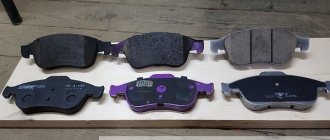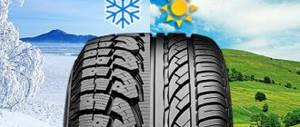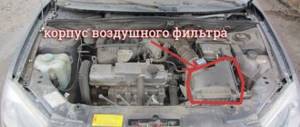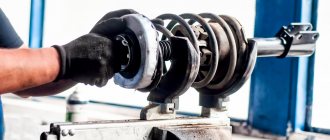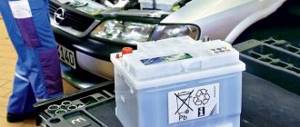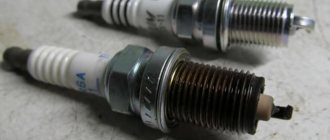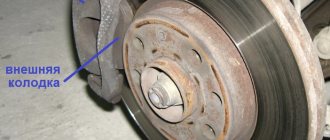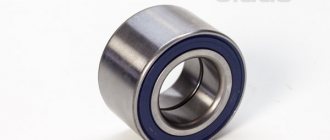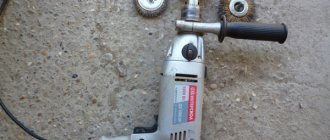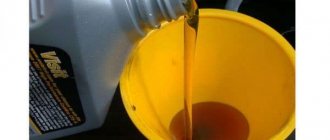Brake pads (brake shoes) are plates with a friction layer that are pressed against the brake disc or drum when you press the brake pedal. As a result, a frictional force arises between the pad and the working surface of the brake disc/drum, which slows down the rotation of the wheel.
During the operation of the car, the brake pads inevitably wear out, as the friction linings wear out. When wear is critical, braking performance deteriorates sharply, and worn pads can cause failure of other elements of the brake system. For this reason you need to know:
- how to find out pad wear;
- what signs of wear to look out for;
- how to check the pads.
Read more in our article.
Front and rear brake pads: what you need to know about wear
Every driver knows that depending on the force of pressing the pedal, it is possible to brake smoothly or sharply. When you press the brake pedal hard, the pads completely block the wheels. It is also important to take into account that the braking force on the front and rear axles of the car is different.
As a rule, in normal modes (soft braking), the car stops almost exclusively due to the front wheels only. If the braking is active or emergency, only in this case the rear brake circuit is connected.
In practice, this means that the front pads wear much more actively than the rear ones. For this reason, they need to be changed more often. By the way, taking into account such features, many manufacturers, in order to save money, install front disc brakes on budget cars and some middle-class models, while simple drum brakes are installed on the rear axle. If there are closed drums at the rear, pad wear in such a system is more difficult to diagnose.
When to change brake pads
In the case of pads, it is difficult to clearly determine how long the pads last and when replacement is needed. In some cases, the pads can be worn out within 10 thousand km, while in others these elements can last 20, 30 thousand km or more.
The fact is that different cars are used in different conditions. The wear rate of brake pads is influenced by a number of factors: driving style, vehicle load, road conditions, the quality of the pads themselves, as well as other features of the vehicle’s operation.
As practice shows, for calm drivers who drive on good roads at a constant speed, do not load the car and practice smooth braking from medium and low speeds, front brake pads of average quality usually last at least 25-35 thousand km.
Rear pads can last about 50-60 thousand km. If the car is used more actively and aggressively, the pads wear out much earlier, especially the front ones.
Signs of Brake Pad Wear
As a rule, if the pads are worn out, it is important to pay attention to the following:
- braking performance deteriorates;
- vibrations and jerking appeared when braking;
- during braking, extraneous noises are heard (grinding, whistling, etc.);
- the car clearly “steers” when braking in one direction or the other;
- the brake pedal travel has increased;
The main reasons are severe wear of the friction linings or their separation from the surface of the pad itself, uneven wear of the pads on the wheels, etc. At the same time, the problem with the pads cannot be ignored, since after the “soft” friction layer wears out, metal friction will begin on the surface of the disc or drum.
The result is severe overheating of the brake mechanisms, the working surface of the disc or drum will receive deep scratches (the discs or drums will need to be ground or completely replaced).
To notify the driver when to change the brake pads (the wear of the pads has reached a critical point), many manufacturers put a special layer on the pads that produces a whistle or squeak when braking. If such a whistle appears, it is necessary to check the brake pads, the wear of which has caused the extraneous sounds.
Also, some cars have special brake pad wear sensors. At the same time, you should not rely only on indicators in the form of a whistle and readings from electronic sensors. It is optimal to check the pads yourself or at a service center.
When should you replace brake pads?
Every diligent owner of his car regularly inspects it before leaving, checking the level of oil, brake and coolant. But many car owners don’t even think about periodically checking such “little things” as brake pads (bars), but in vain. There can be no trifles in the issue of accident-free driving, because safety and, in some cases, people’s lives directly depend on their condition.
It is clear that there is no point in dismantling the wheel every time to check the condition of the bars; there are certain signs that tell the driver about the approaching time for their replacement. In this article we will look at how to determine brake pad wear. And also what type of slats are there, which of them have to be changed more often: front or rear. How many thousands of kilometers can they run and what, in general, should be paid attention to.
The main working material responsible for the process of stopping a car is a friction layer attached to the metal part of the block. The ideal combination of materials used in their production has not yet been achieved. There are currently four types of brake bars produced:
- Pads with a semi-metallic friction layer applied to them, in which up to 65% of the components are copper, steel wire or iron powder, mixed with graphite for better friction. Their advantage is high heat transfer, and their disadvantages are rapid wear and noise.
- Planks with material glued to them from organic components: high-temperature resin, rubber, glass, Kevlar and carbon. Their positive qualities include less noisy operation and softness, while their negative qualities include a shorter service life and a sufficient amount of dust emitted by them.
- Pads with a small content of metal elements, no more than 30%, with the addition of organic substances (described above). This contributes to good heat transfer, but affects their noise.
- Ceramic planks are currently considered the best option. Their friction layer is made of ceramic fibers with the addition of a filler that includes a small amount of copper. Being lightweight, these pads are more durable in operation and produce less noise.
Let's look at the factors that influence how often your brake pads will need to be replaced. There are few of them, but they directly affect indicators such as how long it will take for this to happen, and how many kilometers the car will travel before the corresponding indicator on the instrument panel works. Here are some of them:
- Travel mode. When the car moves in the city, it is often necessary to stop at short intervals, which contributes to rapid wear of the bars.
- Driving style. A non-aggressive driving style puts less stress on the brake mechanism and increases the interval after which the pads will need to be changed.
- The nature of the machine loading. When the trunk is constantly loaded, the load on the front brake trims is reduced, and accordingly, they will need to be changed less often.
Based on the model of the brake mechanism and the friction material of the bars, manufacturers indicate how many thousands of kilometers the pads can last. Manufacturers also recommend when it is necessary to change the strips, focusing on the remaining minimum permissible friction layer.
All this is described in the instructions for the car, but there are average standards, the value of which ranges from 20 to 30 thousand km, for the front slats in disc brakes. And for drum and disc type rear brake pads, this mileage interval in km must be multiplied by two.
The weight of the machine also plays a big role in the wear rate. The above figures are relevant for small passenger cars weighing up to 1300 kg. If we consider large sedans weighing about 1600 kg, then the wear of the bars will occur one and a half times faster. For cars with a curb weight of 1800 kg or more, the pads will need to be replaced after they have covered a distance half as much as a small passenger car can travel.
If the car was bought used, there is often no way to find out when the pads were last changed and what their mileage was. Some signs will help you understand that it’s time to replace them:
- The pad wear warning light on the instrument panel came on. Some brake pads have an electronic or mechanical indicator that signals when the friction material has worn down to the minimum limit and it is time to replace them.
- There was a sound when the car stopped. This sound occurs at a certain percentage of wear of the friction material, when it is worn down to metal.
- When stopping suddenly, a sound is heard and a beating is felt in the area of the wheels. The reason for this is uneven wear of the pads or cracks and chips that may occur on the disc or friction layer. In this case, even the indicator, if present, may not work. Uneven wear of the friction layer is dangerous because after a certain number of kilometers you will have to change not only the strips, but also the wheel disk or drum.
(Caution! Loud sound.)
- The braking distance and the time spent stopping the car have increased. This happens when uneven or complete wear of the strips occurs, in which case they need to be replaced urgently.
- Skidding due to uneven operation of the brakes, when one of the wheels grabs faster, and the second, on which the pads are worn, slows down.
The most accurate way to know that it is time to change the brake pads is to regularly visually inspect them after the car's mileage has exceeded the generally accepted 30,000 km. In this case, a ruler or caliper will help to correctly determine the condition of the friction layer. At the same time, its permissible residue should not be less than 1.5 or 2 mm, depending on the make of the car.
All of the wear factors described above also apply to rear brake mechanisms, regardless of their type. The only difference is that the testing methods for rear disc brakes are similar to the front ones. The only difference that is relevant for drum brake pads is that their wear can also be determined by the operation of the hand brake. If, when the handbrake is depressed on a slope, the bars do not keep the car from rolling, then it’s time to replace them.
Also, when visually inspecting the condition of the drum brakes, some car models have a window in the drum. By looking at it, you can determine the degree of wear of the friction layer of the pads.
The brake system, in particular pads and discs, is one of the most heavily loaded and intensively used components of a car. Theoretical replacement intervals are usually indicated in the operating manuals for specific machine models.
However, in practice, everything is different - they need to be changed as they wear out, the intensity of which depends on the material of manufacture, atmospheric conditions, condition of the road surface, driving style, etc.
There is nothing complicated in the design of brake pads: they are steel plates to which are attached special linings made of high-strength materials that are resistant to friction and temperature changes.
Manufacturers indicate in the technical documentation how long their products will last, but this information is for advisory purposes only. You can determine in advance how often you will have to buy new consumables.
On average, brake pads are replaced at the following mileage:
- domestic cars: 12/-3 thousand km;
- imported cars: 17/-3 thousand km;
- sports cars: 5/-1 thousand km.
The easiest way to determine when the pads need to be replaced is by the wear sensors and/or the indicator on the dashboard, if provided for this model. Additional signs of the need for replacement are a “light” pedal, increased braking distance and increased fluid consumption.
A characteristic sign of brake failure will be a specific sound during heavy braking. After the pads are worn, the sensor plate emits a characteristic squeak when in contact with the surface of the disc. The design of most foreign cars includes light indicators that are connected through contacts built into the pad linings.
If the car does not have any mechanical or other means of signaling the condition of the brakes, you should periodically check their wear by measuring the size of the linings of both rear and front wheels without taking into account the metal base. Replacement is required if the thickness of one of the pads is less than 1.5 / -0.5 mm. If the car has alloy wheels with large holes, this check is not difficult to perform visually, even without removing the wheels.
Unlike pads, brake discs last much longer. In most cases, they are changed after 80 thousand kilometers. More accurately, the service life is indicated in the technical documentation of a specific model, but this data is also conditional.
Manufacturers use different technologies and materials, which affects the rigidity and strength of various modifications of disks. The amount of wear depends on the quality of the pads, driving style, road conditions, weather conditions and other factors.
To know when to replace your brake discs, you should regularly monitor their condition. Excessive wear may cause the following anomalies in the machine:
- Increased braking distance;
- Reduced level of working fluid;
- Lightening the pedal;
- “Pulling” to the side when braking;
- Uncharacteristic noise in the wheel area.
If one of the above deviations occurs, it is necessary to check the condition of the brake system. In this case, special attention should be paid to both discs and pads. It is best to entrust this to qualified service center specialists.
Systematic inspection of brake discs is required on both the front and rear wheels. In addition to the condition of the surface, you need to measure their thickness using a caliper. The acceptable range for use is usually indicated on the back of the disc.
Note. Replacing discs, like pads, regardless of which mechanism has unacceptable wear, must be done on one axis only in pairs.
How to check the pads on a car
To check, you need to know how to determine pad wear. You can do this in two ways:
- assessing the quality of the brake system;
- by visual inspection of the brake pads.
The first method is superficial and is more suitable for experienced drivers who are used to operating a specific vehicle and can evaluate how fully functional brakes should work. You can also focus on the signs of pad wear discussed above: squeaks when braking, increased braking distance, beating, changes in brake pedal travel, etc.
We also recommend reading the article on how to replace brake pads on a car with your own hands. From this article you will learn about the features of replacing brake pads on the front and rear axles.
The second method is more accurate and allows you to determine pad wear by external signs. At the same time, it is recommended to carry out such a check every 3-5 thousand kilometers. To check you will need:
- inspect the wheel rim for the presence of friction dust (gray coating). If such deposits are present, this indicates the presence of a friction layer on the block, which is gradually wearing away. However, if metal particles are visible in the plaque, this indicates that the lining is worn out and the process of abrasion of the metal of the pad itself has begun.
- remove the wheel and inspect the pads (through the “window” in the caliper or by completely removing the pads). This method is the most accurate and allows you to visually assess the thickness of the linings, the degree of wear, the presence of defects, etc. For drum brakes, you will also need to remove the drum cover.
If the friction lining is worn out or has visible defects, the pads need to be replaced. It is important to take into account that replacing brake pads is carried out only in pairs (on both wheels on the same axle). This means that it is impossible to change only one pad or pads on one wheel, since for maximum stability of the car when braking, the wheels must brake equally.
When to change rear pads?
March 31
The rear pads, just like the front ones, are part of the car's braking system. The brake pad is a steel plate with a friction lining. The material from which the lining is made has a high coefficient of friction, and it must have high wear resistance and heat resistance. Each manufacturer keeps the composition of the friction material secret. Some people use ceramics to increase pad life.
Pads are installed on each wheel. Their job is to clamp the brake disc or drum, slowing down the rotation of the wheel and stopping movement. The front and rear pads in a disc system are located outside the disc, so they are not protected from environmental influences, foreign objects, dirt and dust.
Most modern passenger cars are equipped with disc systems; drum systems are rarely installed, usually on the rear axle. Drum systems can also be seen on heavy trucks.
The rear pads differ from the front ones in being smaller in size. This is due to the fact that when braking, a large load falls on the front wheel axle. And this is also related to the fact that the front brake pads fail faster.
The brake system provides speed control and smooth braking without skidding. The operation of the braking system is based on the use of friction and braking force created by the engine, transmission and the braking mechanism itself.
Modern cars use a friction brake mechanism, which consists of a caliper, a working cylinder, brake discs or drums and pads. Braking systems in cars are complemented by various devices - anti-lock braking system, electronic sensors, electric or pneumatic drive, etc.
When you press the brake pedal, force is transmitted to the brake master cylinder, which forces fluid into the brake hose. Under fluid pressure, the caliper begins to move and the brake pads are pressed against the disc or drum. High friction is created and the wheels stop rotating. The car stops.
The performance of the entire braking system depends on how well the brake pads work. Accordingly, driving safety, comfort and vehicle controllability depend on the condition of the front and rear pads. The thinner the brake pad friction lining, the greater the force required to apply to the brake pedal, which increases the load on the driver. Braking becomes less effective and stopping distance increases.
The front pads fail earlier than the rear ones, as they experience greater load when braking. However, this does not mean that the rear pads do not need to be changed at all. They also require replacement within a certain time frame, since if the replacement is untimely, the car will skid when braking, and it will be difficult to drive such a car, which can lead to serious accidents.
Information about the timing of replacing pads is indicated in the vehicle registration certificate. The manufacturer indicates the minimum permissible thickness of the friction lining at which the car can be operated - usually 2 mm.
Many car owners focus on maximum mileage or a certain service life. However, you should know that brake pad wear depends on operating conditions, climatic conditions, driving style and the regularity of scheduled maintenance.
Replacing the front and rear brake pads is a planned procedure, and you shouldn’t delay it until signs of trouble appear. If you're unsure whether it's time to replace your pads, get a routine inspection. Also undergo scheduled maintenance at least 2 times a year. During the inspection, the auto mechanic will tell you whether it is worth changing the pads or whether you can wait a little longer.
Malfunctions can occur in any part of the brake system. Most often they occur due to severe wear of the brake pads. There are several signs that can indicate worn front and rear brake pads.
If your car is equipped with a pad wear sensor, when the friction lining becomes thin, it begins to emit a characteristic squeak during braking. If your car has an electronic sensor, if the friction lining becomes too thin, a warning light on the dashboard will light up.
As brake pads wear, brake fluid consumption increases because the caliper must work with more force to press the pad against the rotor. This requires more hydraulic pressure from the brake fluid, resulting in a lower fluid level.
When a pad wears out, more force is required for the caliper to press the pad against the disc. As a result, more force is required from the driver when pressing the brake pedal, and the travel of the pedal itself increases noticeably.
Damage to the front and rear pads, visible to the naked eye, indicates the need for urgent replacement. These could be cracks, abrasions, thin friction material, or damage to the discs.
Uneven wear on the brake pads on one axle may indicate that the caliper is not working properly and needs to be replaced. If you do not replace the caliper in time, even new pads will quickly fail in the future, and braking will not be effective enough.
The need for urgent replacement of pads and other parts of the brake system is indicated by a sharp increase in braking distance. Ineffective braking may be due to excessive wear on the front or rear pads, poor caliper function, or insufficient brake fluid levels.
Buy pads that meet the vehicle manufacturer's recommendations. If you don't know which pads are needed, consult with an auto mechanic who will replace the pads. It is important to remember that the pads must be changed simultaneously on the entire axle. Therefore, immediately buy all the front pads, or all the rear pads, or a complete set.
You can choose both original spare parts and high-quality analogues. Try to buy only new pads, since traffic safety and driving comfort depend on their quality.
Do not buy used pads, as their quality is not always good, and used parts have a small residual life. You can choose contract pads, but only if their quality is beyond doubt and the thickness of the friction lining is large enough.
Don't skimp on your purchase. Remember: a low price is not always worth it when it comes to the safety of you, your passengers and other road users. In addition, cheap pads with soft friction material can quickly fail and will have to be replaced more often.
You should not buy pads with asbestos linings. They wear out quickly, and asbestos dust, which is formed when the pad rubs against the disc during braking, is harmful to health. Pads with asbestos components are practically not produced.
Road safety and driving comfort depend on the quality of brake system repairs and proper replacement of pads and discs, so the pad replacement procedure can only be trusted by a trusted specialist.
It is best to replace the front and rear pads in a good car service center, where there is the necessary equipment and a guarantee for all types of work performed. For example, in “Available Service”:
- Experienced specialists who regularly improve their skills work here.
- The necessary modern equipment is available.
- All work has a 30 day guarantee.
- A list of work performed on each vehicle is entered into a computer database.
- Large selection of spare parts, new original and high-quality analogues, in stock and on order.
- A wide range of services for trucks and cars of any make and year of manufacture.
- When you first apply, a 30% discount is provided.
- 15% discount on spare parts when purchasing and ordering repair work at the same time.
- Free car top washing when ordering any service.
You can get detailed information, find out the cost of spare parts and make an appointment to replace the front and rear pads by phone. “Available service” is located at: Krasnoyarsk, Severnoye shosse, 17d, building 19.
Recommendations
During the operation of the vehicle, the brake pads must be checked even if there are no obvious signs of wear. The main reason is to prevent critical wear and maintain braking efficiency. The fact is that during active braking, high heating of the brake discs, pads and calipers occurs.
It often happens that the linings that are still working, but worn out, cannot withstand overheating in active mode. For this reason, experts recommend changing the pads in advance (when the pads are worn about 70%). This will allow you to get the most effective braking in different conditions (up to an emergency stop).
We also recommend reading the article about why the pads squeak or whistle when braking. From this article you will learn about the main causes of whistling or squeaking pads, as well as how to solve this problem.
In order to understand when to change the rear brake pads, you should pay attention to the wear rate of the front ones. It is optimal to replace the pads on the rear axle parallel to every second replacement of the front pads for disc brakes, and also parallel to every third replacement for drum brakes.
If you plan to drive on the highway (especially over long distances), operate the car in mountainous areas, or plan to transport cargo and a large number of passengers, worn brake pads will cause a significant deterioration in the effectiveness of the brakes. For this reason, it is necessary to replace the pads in advance, and it is also advisable to replace the brake fluid and bleed the brakes on the car.
Signs of wear
The driver can learn about the degree of wear of the pads by indirect signs. It is only necessary to correctly interpret these signals. One of the main symptoms is an increase in braking distance, as well as a violation of straightness during braking. Negative factors include an extended pedal stroke and a noticeable decrease in its rigidity.
The car owner should check the condition of the linings during intermittent locking during braking. This occurs after abrasion of rubber, resins and other inclusions, after which frictional interaction of the metal elements of the pad with the brake disc occurs.
Wear creates the appearance of wheel runout when braking. Creaks, rattles and other extraneous noises appear. This behavior can lead to jamming of the pads and complete blocking of the wheel, which will have a devastating effect on the entire assembly.
Modern cars are equipped with specialized pad condition sensors . Once the pad drops to a critical size, the driver receives a corresponding notification. Mechanical devices will make squeaking noises. For electronic monitoring units, a light signal is provided on the instrument panel. The light comes on every time the ignition is turned on.
Also, some manufacturers apply special control grooves, and when the lining wears off to such an extent that the grooves disappear, it needs to be changed. It is undesirable to bring the pads to a state in which the lining decreases below 2...3 mm .
The brake system, in particular pads and discs, is one of the most heavily loaded and intensively used components of a car. Theoretical replacement intervals are usually indicated in the operating manuals for specific machine models.
However, in practice, everything is different - they need to be changed as they wear out, the intensity of which depends on the material of manufacture, atmospheric conditions, condition of the road surface, driving style, etc.
There is nothing complicated in the design of brake pads: they are steel plates to which are attached special linings made of high-strength materials that are resistant to friction and temperature changes.
